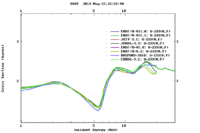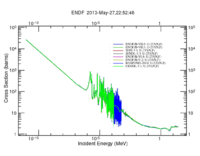Fission fragment trasport out of U-233
U-233 Coating
The fission chamber has a fissionale material as a sensitive neutron target. The fission chambers have usually target material that make them sensitive for neutrons, them most commonly used material for detecting thermal neutron is U-235, in case of fast neutron Th-232 or U-238 represnt good target. in some cases the fission chamber may contain more than one taget to detect a wide range of emitted neutrons.<ref name= "Andriamonje"> Novel Micromegas Detector for In-Core Nuclear Reactor Neutron Flux Measurements </ref>
In this research, the neutron sensitive material used in the fission chamber is Uranium 233. U-233 has a relatively high neutron fission cross section in the energy range of 0.1-30 MeV as shown in the figure below.
The coating on a circular metal plate which is connected to the cathode. The coating of U-233 has a cirular shape of an inch in diameter and 20-40 um in thickness. The circular plate is glued to a square FR4 copper clad plate of length of 12 cm and thickness of 1 mm, the plate has a hole of 4 cm in diameter that keeps the U-233 coating exposed to the chamber gas.
Probability of a fission fragment to create a signal
U-233 is relatively sensitive but the coating thickness may stop the fission fragments. Compared to the other neutron sensitive targets, U-233 is relatively sensitive to a wide energy range of neutrons, the range may extend from 0.1 MeV to more than 30 MeV. However, coating thickness determines the if a fission fragment can escape from its surface and to cause an ionization in the gas to create a signal. The range of a fission fragment is calculated in UO3, of thickness 0.1 um and density 7.29 g/cm^3, is 12.07 +_ 0.09 um, <ref name = Hudler> J.C. hadler, Radiation Measurements Vol 43 (2008) pf S334-S336</ref> assuming the fission fragment mobility is the same as the UO3. As the thickness increases more than 0.1 um, the range will decrease according to the following equation:
<references/>

